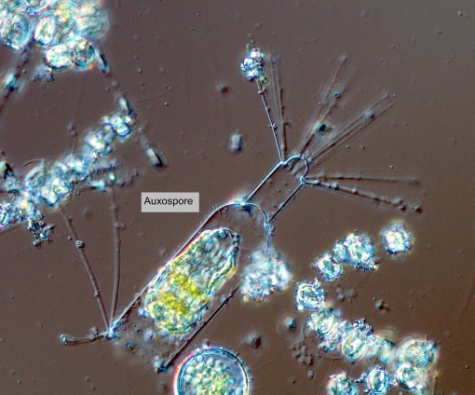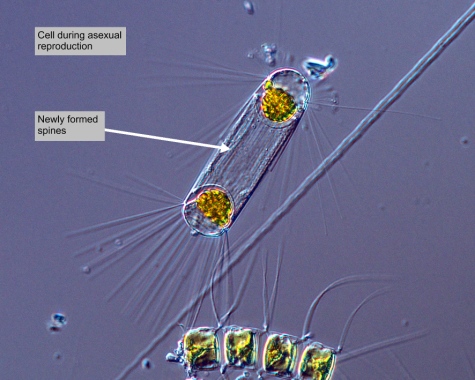






|
 |
Synonym(s)
Corethron valdivae Karsten 1904
(Guiry 2011)
Classification
(Guiry and Guiry 2011)
Lifestyle
Auxospore
In diatoms, the special cells that restore normal size following cell division. Auxospores are associated with sexual reproduction (Horner 2002).
Auxospores present (Cupp 1943).Description
Spine
In some diatoms, "closed or solid structures projecting from the cell wall;" in dinoflagellates, solid projections that usually taper to a point.
spines directed outwards. The other valve has a set of similar spines facing inwards and another ring of short, hooked spines also directed outwards. Chloroplasts are numerous and CloseDiscoid
Disc-shaped.
discoid (Cupp 1943, Horner 2002).Intercalary bands
Girdle bands that are furthest away from the valve (Smithsonian 2011).
Intercalary bands are collar-like but indistinct (Cupp 1943).Measurements
Pervalvar axis
The axis through the centre point of the two valves of a frustule. This axis is perpendicular to the valve face.
(pervalvar axis): 20 - 300 μmDiameter: 5 - 38 μm
(Hendey 1937, cited in Hasle and Syvertsen 1997; Cupp 1943)
Similar species
Harmful effects
Habitat
Distribution
Close
Cosmopolitan
Widely distributed; occurring in many parts in the world.
Cosmopolitan, recorded as far north as ∼80 °N (Heimdal 1983, cited in Hasle and Syvertsen 1997) and most abundant in Antarctic waters (Fryxell and Hasle 1971, cited in Hasle and Syvertsen 1997).Usually found in spring and fall, occasionally in the summer (Haigh 2010).
"Fairly common off California, in Gulf of California, and north to Scotch Cap, Alaska. North temperate species" (Cupp 1943).
Growth conditions
Quota
(as in, cell quota for a nutrient) The amount of a macro- or micronutrient required by an organism to fulfill its life cycle.
quota: 0.041 Si:CSaturating cell quota: 0.158 Si:C
N-saturating cell quota: > 0.106 N:C
(Sommer 1991).
Environmental Ranges
Temperature range (°C): -1.596 - 29.468
Nitrate (μmol L-1): 0.053 - 34.037
Salinity (PSU): 30.119 - 36.252
Oxygen (mL L-1): 3.946 - 8.562
Phosphate (μmol L-1): 0.046 - 2.366
Close
Silicic acid
A general term to describe chemical compounds containing silicon, oxygen and hydrogen with a general formula of [SiOx(OH)4-2x]n. Diatoms polymerize silicic acid into biogenic silica to form their frustules (Azam and Chisholm 1976).
Silicate (μmol L-1): 0.648 - 116.089(OBIS, cited in EOL)
Bloom characteristics
References
Aizdaicher, N. A. and Markina, Z. V. 2010. The Effect of Decrease in Salinity on the Dynamics of Abundance and the Cell Size of Corethron hystrix (Bacillariophyta) in Laboratory Culture. Ocean Science Journal. 45(1): 1-5.
Cupp, E. E. 1943. Marine Plankton Diatoms of the West Coast of North America. University of California Press. Berkeley, California. 238.
Encyclopedia of Life. Corethron criophilum Castracane. http://www.eol.org/pages/911906. Accessed 15 Jun 2011.
Fryxell, G. A. and Hasle, G. R. 1971. Corethron criophilum Castracane: Its distribution and structure. Antarctic Research Series 17, Biology of the Antarctic Seas. 4: 335-346.
Guiry, M. D. 2011. Corethron criophilum Castracane, 1886. World Register of Marine Species at http://www.marinespecies.org/aphia.php?p=taxdetails&id=149110. Accessed 15 Jun 2011.
Guiry, M. D. and Guiry, G. M. 2011. Corethron criophilum Castracane. http://www.algaebase.org/search/species/detail/?species_id=37635. Accessed 15 Jun 2011.
Haigh, N. 2010. Harmful Plankton Handbook. HAMP 2010.
Hasle, G. R. and Syvertsen, E. E. 1997. Marine diatoms. In: Tomas, C. R. (ed.) Identifying marine Phytoplankton. Academic Press, Inc., San Diego. 5-385.
Heimdal, B. R. 1983. Phytoplankton and nutrients in the waters north-west of Spitsbergen in the autumn of 1979. Journal of Plankton Research. 5: 901-918.
Hendey, N. I. 1937. The plankton diatoms of the Southern Seas. Discovery Reports. 16: 151-364.
Horner, R. A. 2002. A Taxonomic Guide To Some Common Phytoplankton. Biopress Limited, Dorset Press, Dorchester, UK. 200.
Ocean Biogeographic Information System. Corethron criophilum. http://www.iobis.org/mapper/?taxon_id=426899. Accessed 15 Jun 2011.
Sommer, U. 1991. Comparative nutrient status and competitive interactions of two Antarctic diatoms (Corethron criophilum and Thalassiosira antarctica). Journal of Plankton Research. 13(1): 61-75.
Whyte, J. N. C., David, J. C. and Forbes, J. R. 1997. Harmful algae in Canadian waters and management strategies. Ocean Research. 19(2): 161-171.
